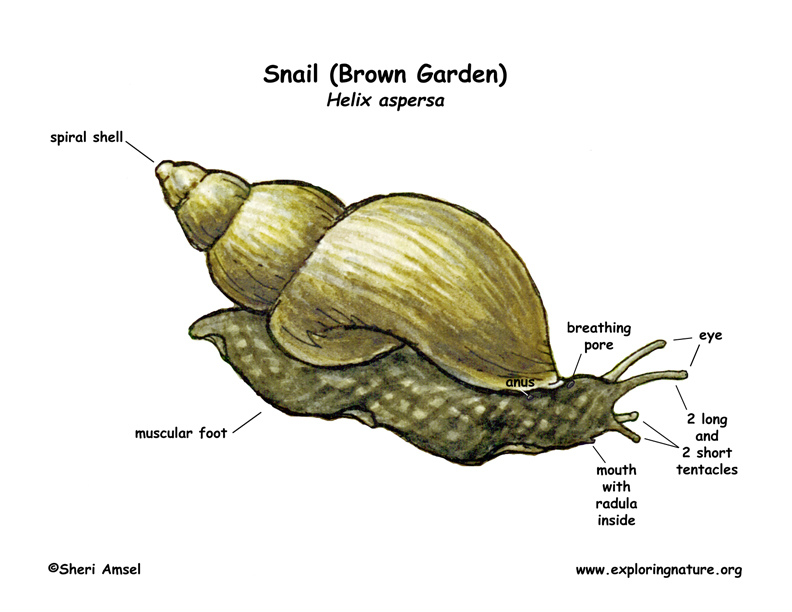

They are found throughout the world in temperate climates.
They live in the moist vegetation of gardens, woods and yards.
The have a muscular foot with which they move. They secrete a thick mucus that helps them move over surfaces and leaves a trail. They have a spiral shell inside and around which their body wraps. The shell has ringed markings and is yellowish-brown. The shell reaches about 1.5 inches wide (4 cm) and has a tough plate, called an operculum, that can seal the snail inside in case of danger. They have a rough, tongue-like structure, called a radula, with which they scrape away at food. They have two pairs of tentacles, only one bearing eyes at the end. They breathe through respiratory pores, the oxygen being absorbed directly into the abundant tiny blood vessels of the mantle.
They are active at night (nocturnal). They will emerge during day after a rainfall. They survive the winter by hibernating.
The garden snail is a herbivore eating (and damaging) many types of plants including fruit trees, vegetable crops, garden flowers, and grasses. It is a food source for many other animals, including small mammals, many bird species, lizards, frogs, centipedes, predatory insects, predatory terrestrial snails and man.
Each snail contains both male and female reproductive parts. This makes them “hermaphrodites.” They still choose to mate with other snails, though they can fertilize themselves. During a mating session of several hours, two snails exchange sperm. The garden snail uses ‘love darts’ during mating. Love darts are sharp, slimy, mucus coated projectiles fired at the snail’s sexual partner. About two weeks after mating approximately 80 spherical pearly-white eggs are laid into crevices in the topsoil. Up to six batches of 80 eggs can be laid in a year. The size of the egg is 4 mm. and young snails take one to two years to reach adulthood.
Need to know more about snail anatomy? Go to > Main Index > Biology/Life Science > Invertebrate Animal Classification > Phylum - Mollusca (Gastropods, Bivalves, Cephalopods) and then scroll down to Gastropods.
Kingdom: Animalia
Phylum: Mollusca
Subphylum: Vertebrata
Class: Gastropoda
Order: Stylommatophora
Family: Helicidae
Genus: Helix
Species: H. aspersa
When you research information you must cite the reference. Citing for websites is different from citing from books, magazines and periodicals. The style of citing shown here is from the MLA Style Citations (Modern Language Association).
When citing a WEBSITE the general format is as follows.
Author Last Name, First Name(s). "Title: Subtitle of Part of Web Page, if appropriate." Title: Subtitle: Section of Page if appropriate. Sponsoring/Publishing Agency, If Given. Additional significant descriptive information. Date of Electronic Publication or other Date, such as Last Updated. Day Month Year of access < URL >.
Amsel, Sheri. "Snail (Garden)" Exploring Nature Educational Resource ©2005-2024. December 13, 2024
< http://exploringnature.org/db/view/Snail-Garden >

